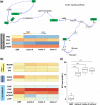An Orphan Gene Enhances Male Reproductive Success in Plutella xylostella
- PMID: 38990889
- PMCID: PMC11290247
- DOI: 10.1093/molbev/msae142
An Orphan Gene Enhances Male Reproductive Success in Plutella xylostella
Abstract
Plutella xylostella exhibits exceptional reproduction ability, yet the genetic basis underlying the high reproductive capacity remains unknown. Here, we demonstrate that an orphan gene, lushu, which encodes a sperm protein, plays a crucial role in male reproductive success. Lushu is located on the Z chromosome and is prevalent across different P. xylostella populations worldwide. We subsequently generated lushu mutants using transgenic CRISPR/Cas9 system. Knockout of Lushu results in reduced male mating efficiency and accelerated death in adult males. Furthermore, our findings highlight that the deficiency of lushu reduced the transfer of sperms from males to females, potentially resulting in hindered sperm competition. Additionally, the knockout of Lushu results in disrupted gene expression in energy-related pathways and elevated insulin levels in adult males. Our findings reveal that male reproductive performance has evolved through the birth of a newly evolved, lineage-specific gene with enormous potentiality in fecundity success. These insights hold valuable implications for identifying the target for genetic control, particularly in relation to species-specific traits that are pivotal in determining high levels of fecundity.
Keywords: insulin; male reproductive fitness; orphan gene; sperm competition; sperm protein.
© The Author(s) 2024. Published by Oxford University Press on behalf of Society for Molecular Biology and Evolution.
Conflict of interest statement
Conflict of Interest None declared.
Figures







Similar articles
-
Nap1 is essential for eupyrene spermatogenesis and migration in Plutella xylostella.Insect Biochem Mol Biol. 2025 Feb;177:104245. doi: 10.1016/j.ibmb.2024.104245. Epub 2024 Dec 5. Insect Biochem Mol Biol. 2025. PMID: 39645055
-
Verification of AKT and CDK5 Gene and RNA Interference Combined with Irradiation to Mediate Fertility Changes in Plutella xylostella (Linnaeus).Int J Mol Sci. 2024 Apr 24;25(9):4623. doi: 10.3390/ijms25094623. Int J Mol Sci. 2024. PMID: 38731841 Free PMC article.
-
Sast1-mediated manifold effects inhibit Plutella xylostella fertility.Pest Manag Sci. 2024 Jun;80(6):2596-2609. doi: 10.1002/ps.7966. Epub 2024 Jan 22. Pest Manag Sci. 2024. PMID: 38252701
-
Functional characterization of the cis-regulatory region for the vitellogenin gene in Plutella xylostella.Insect Mol Biol. 2020 Apr;29(2):137-147. doi: 10.1111/imb.12632. Epub 2020 Jan 8. Insect Mol Biol. 2020. PMID: 31850544 Review.
-
Selfish genetic elements and sexual selection: their impact on male fertility.Genetica. 2008 Sep;134(1):99-111. doi: 10.1007/s10709-008-9253-y. Epub 2008 Mar 8. Genetica. 2008. PMID: 18327647 Review.
Cited by
-
An orphan gene is essential for efficient sperm entry into eggs in Drosophila melanogaster.Genetics. 2025 Mar 17;229(3):iyaf008. doi: 10.1093/genetics/iyaf008. Genetics. 2025. PMID: 39903197
-
An orphan gene is essential for efficient sperm entry into eggs in Drosophila melanogaster.bioRxiv [Preprint]. 2024 Dec 14:2024.08.08.607187. doi: 10.1101/2024.08.08.607187. bioRxiv. 2024. Update in: Genetics. 2025 Mar 17;229(3):iyaf008. doi: 10.1093/genetics/iyaf008. PMID: 39149251 Free PMC article. Updated. Preprint.
-
Genomic Analysis Reveals the Role of New Genes in Venom Regulatory Network of Parasitoid Wasps.Insects. 2025 May 7;16(5):502. doi: 10.3390/insects16050502. Insects. 2025. PMID: 40429215 Free PMC article.
-
Chromosome-level genome of the brown lacewing Micromus angulatus (Stephens, 1836) (Neuroptera: Hemerobiidae).Sci Data. 2025 Mar 6;12(1):394. doi: 10.1038/s41597-025-04739-w. Sci Data. 2025. PMID: 40050286 Free PMC article.
References
MeSH terms
Substances
Grants and funding
LinkOut - more resources
Full Text Sources

